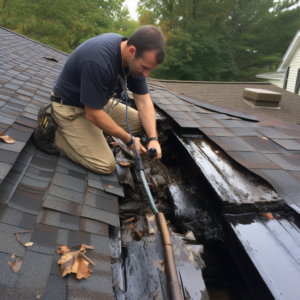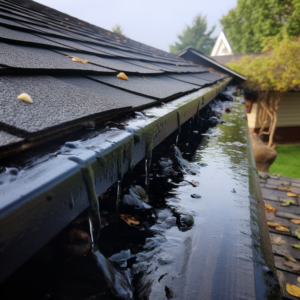Home is a place where we should feel the most comfortable and secure. However, this sense of safety can be severely compromised when the bane of roof leaks show up, causing more than just a minor inconvenience. Leaking roofs may lead to substantial damage over time, both to the internal structures of the house and to residents’ peace of mind. Understanding the factors leading to these leaks and enacting measures for their prevention is integral to the maintenance of a secure, dry home environment.
Understanding the Causes of Roof Leaks
Construction issues are foundational when talking about the reasons behind a leaking roof. Poor workmanship plays a significant part in this, highlighting the importance of using trained, reliable tradespeople in the construction of your home. Mistakes during installation, such as incorrectly laid underlayment, imbalanced roof system design, or a lack of essential components, can lead to roof leaks. Errors committed during the construction phase often lead to expensive, complicated repairs later on, turning a safe haven into a source of stress.

Sometimes, even the best-made roofs can be brought to their knees by the fury of mother nature. Extreme weather conditions form one of the greatest threats to a roof’s integrity. Whether it’s the damaging high winds of cyclones and storms, the relentless, harsh rays of the sun, or continuous snowfall and freezing winter conditions, nature’s elements can lead to significant wear and tear on roofing materials.
While those are significant causes, often, it’s the small things that lead to the most considerable amount of damage. Damaged or missing shingles and tiles are prime culprits when it comes to roof leaks. These roofing elements, often exposed directly to the harsh elements, form the primary barrier against moisture. Their damage could result in a compromised underlayment, leading to persistent leaks.
Culminating the discussion on the causes of roof leaks, let’s not forget about one of the significant components, often overlooked – the flashing. These thin pieces of weather-resistant metal, installed at every intersection or joint on a roof, are designed to prevent water ingress. However, poorly installed or damaged flashings can create the very leaks they were designed to prevent.
Every roof, no matter how well built or maintained, has a life expectancy. As years roll in, the wear and tear on roofing materials begins to exhibit in the form of weakened resistance to water, making older roofs more susceptible to leakages.
Identifying a Leaking Roof
While it’s somewhat straightforward to recognize conspicuous signs of a roof leak, like directly visible dripping water or prominent water stains, detecting the more subtle indications can be a bit of a challenge. These less conspicuous signs are just as important for the vigilant homeowner; neglecting them could lead to increased damage and potential repair costs.
One of the early warning signs of a leaky roof is the appearance of mold and mildew. It may initially start as unsightly black streaks on ceilings or walls, indicating the presence of moisture, the breeding ground for mold and mildew. In more serious cases, homeowners may spot greenish-black patches, often associated with “black mold.” This mold can present both structural and health issues, making it crucial to address. Another hidden implication of a leaky roof can be seen in roof insulation. The role of insulation, among others, is to control the temperature within the house. However, when the insulation materials are exposed to water, they can become bloated and compromised, failing to provide efficient thermal resistance. Besides reduced efficiency in temperature regulation, wet insulation could also point to a more pressing problem— a silent roof leak.
Changes to the smell and air quality within the home could also be indicative of a leaky roof. The presence of unwanted, often damp smells generally points to some form of excess moisture. If these smells start becoming a regular occurrence, especially after a rainfall or storm, it may suggest that water is leaking and accumulating somewhere, potentially within the roof structure.
While not directly related to the smell, changes in air quality can also point to a roof in need of some attention. Persistent respiratory issues, allergic reactions, or discomfort, especially in individuals who didn’t suffer from these symptoms before, could hint at mold or mildew presence, a byproduct of a leaky roof.
As homeowners, understanding these less obvious signs is critical. Regular visual inspections of the interior of the house, including looking for discolorations or stains on the walls and ceilings, scrutinizing insulation in the attic, and being aware of changes to smell and air quality, remain pivotal preventative actions. Also, maintaining a high level of humidity control in the home can prevent the growth of mildew and mold. While identifying a leaking roof through more subtle signs can seem like an arduous task, it is far from impossible. Vigilance and prompt action in response to these early warning signs can help to rectify and manage roof leaks timely and effectively.
Prevention of Roof Leaks
The most effective approach to preventing roof leaks is maintaining a combination of vigilant observation and swift, proactive action. Conducting regular inspections of the roof and the attic can play a crucial role in identifying possible areas of concern at preliminary stages. These areas might include damaged or time-worn shingles, fractured or dislodge tiles, as well as deteriorated flashings.

Immediate response is non-negotiable when dealing with roof damage. Even seemingly minor issues, if neglected, can snowball into substantial problems that may ultimately compromise the structure and safety of the home. The key is to not delay repair work; as soon as damage is detected, it should be addressed promptly. Just as a well-maintained car runs more efficiently, routine roof maintenance can significantly help prevent leaks. Seasonal chores like cleaning the gutters can prevent water build-up and subsequent damage. It’s also advisable to trim any overhanging tree branches to avoid potential damage from fallen branches or leaf accumulation on the roof. A periodic check on the condition of flashing – the material that seals roof joints is necessary to assess if they are holding up against the elements.
A longer-lasting roof is often a well-inspected one. Professional roofing assessments at regular intervals ensure the roof gets a thorough examination for any early signs of leaks or damage. These professional assessments, combined with your regular upkeep efforts, will result in early detection and mitigation of issues, if any. Professionals can also advise on maintenance tips specific to the type of roof, local weather conditions, and common issues in the neighborhood, helping the homeowner focus their efforts more effectively.
Vigilance and proactiveness are essential to prevent roof leaks successfully. Whether it’s scrutinizing your home for potential problem areas or opting for professional inspections, all steps contribute to the overall longevity of the roof. Remember, waiting to address a minor roof problem might result in having to deal with a major roof crisis later. Being proactive can save a lot of time, money, and inconvenience in the long run.
Hiring a Professional Roofing Contractor
Your roof faces continuous challenges from natural elements and time, and its care should be entrusted to experienced professionals. A qualified, reliable roofing contractor brings expertise, experience, and an array of skills that can not only identify and fix immediate issues but also provide insight for long-term roof health. As a homeowner, your choice of contractor should consider factors such as experience, training, licensing, insurance, and past customer reviews.
Although roof leaks are among the widespread problems homeowners face, they are not unmanageable. A deep understanding of the causes, a keen eye for early signs of leaks, a proactive approach to prevention, and leveraging professional assistance as needed can be incredibly effective in staying on top of roof leaks. So, remember, when a drip disrupts your quiet evening, it is a battle than can be won.